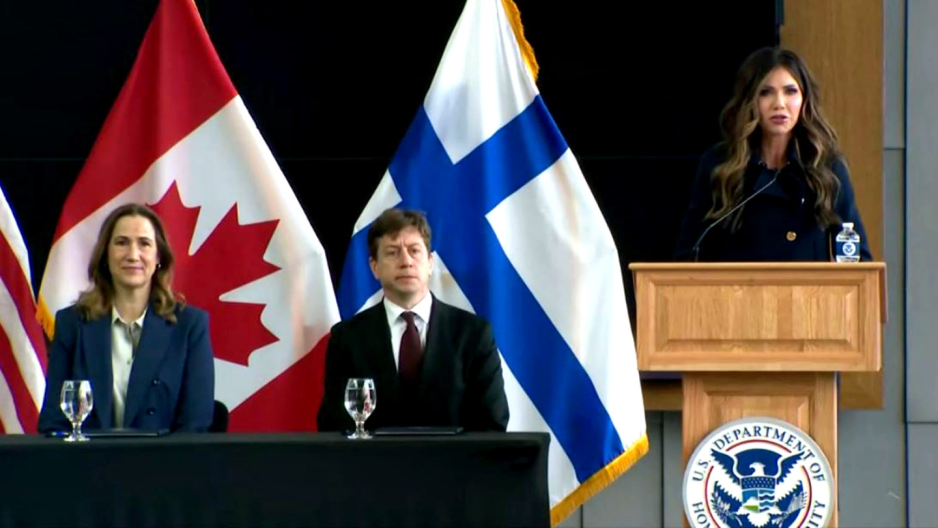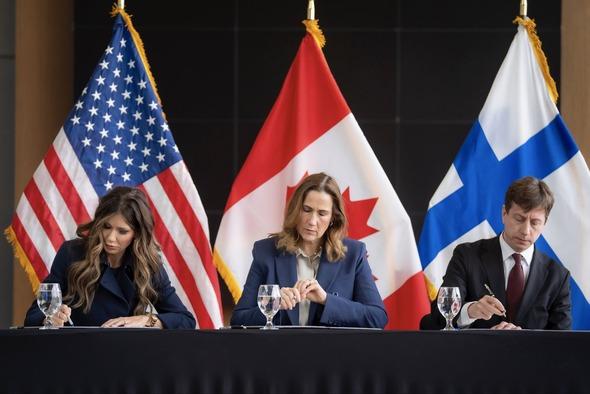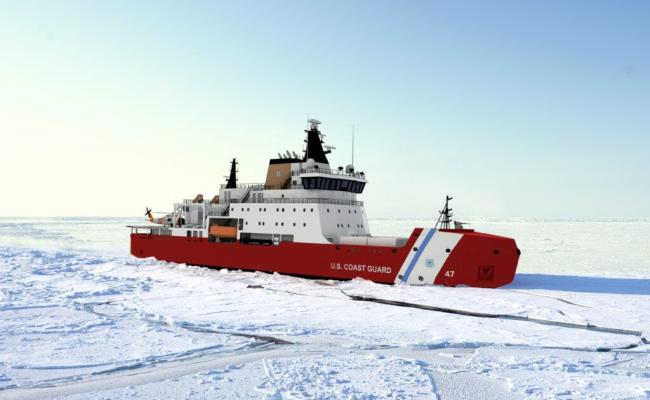US, Canada, and Finland Double Down on Joint Icebreaker Effort in DC Meeting

Homeland Security Secretary Kristi Noem, Canadian Ambassador to the United States Kristen Hillman and Finnish Minister of Economic Affairs Sakari Puisto during DC meeting. (Source: DHS)
The US aims to further revitalize its shipbuilding capacity and Arctic icebreaker fleet under the trilateral ICE Pact. Officials from the three countries met in DC this week to discuss plans for 2026. Earlier this year the pact had resulted in a commitment to construct 11 new icebreakers for the US with participation from shipyards in all three countries.
Officials from the US, Canada and Finland renewed pledges to continue working together under the Icebreaker Collaboration Effort (ICE) Pact. The initiative, originally implemented under the Biden administration, resulted in the first concrete results earlier this year when the US government announced its intention to purchase four icebreakers from two Finnish shipyards.
Under the deal Rauma Marine Constructions (RMC) and Helsinki Shipyard will each build two medium-sized Arctic Security Cutters, with construction then shifting to Bollinger Shipyards in Houma, Louisiana and Davie Shipbuilding's new shipyard in Galveston, Texas for seven additional vessels.
This week’s ministerial meeting in Washington aims to further cement the partnership to revitalize the US maritime industrial base and reinvigorate the country’s icebreaker fleet.
Major milestone
“Today, we marked a major milestone in the race to secure the Arctic against our adversaries,” said Kristi Noem, Secretary of the Department of Homeland Security.
“ICE Pact, the historic trilateral partnership between the United States, Canada, and Finland, will power our economies with good jobs, strengthen our collective Arctic defense, and bring us one step closer to rebuilding our icebreaker fleets. Under President Trump, we are finally asserting our Arctic dominance,” she continued.
The new Joint Statement of Intent aims to further enhance industrial collaboration across icebreaker construction, launch workforce development initiatives, further align cooperation in the region, and advance joining research frameworks.

Homeland Security Secretary Kristi Noem, Canadian Ambassador to the United States Kristen Hillman and Finnish Minister of Economic Affairs Sakari Puisto signing a Joint Statement of Intent. (Source: DHS)
Icebreaker construction and knowledge sharing
Thus far the ICE pact has resulted in a $1bn investment by Canadian shipbuilder Davie acquiring and modernizing a Texas-based yard with plans to turn it into an “American icebreaker factory.”
Finnish yards have also welcomed US maritime sector workers to engage in knowledge sharing under US-sponsored international shipbuilding fellowships.
The trilateral cooperation also extends into research and development in the area of Arctic maritime operations for advanced navigation, remote sensing and environmental monitoring.
“Today is a major milestone in the race to secure the Arctic for all of our countries. The Arctic is the world’s last, most wild frontier, and our adversaries are racing to claim its strategic position and its natural resources for their own,” Noem said following the meeting.
Also read (the article continues):
ICE Pact is key for US
US officials confirmed that the ICE Pact was critical to the accelerated timeline to rebuild the country’s icebreaker fleet.
“The ICE Pact is key to the United States Coast Guard’s strategy to rebuild its aging icebreaker fleet. These icebreakers are necessary to enable navigation in the Arctic region, where America’s adversaries are building a major military presence,” the US Department of Homeland Security said in a statement.
The US’ Arctic icebreaker capabilities had long been on the political back burner during several previous administrations. The Bush, Obama and Biden White Houses had failed to heed the Coast Guard’s calls for funding to construct new icebreakers. Similarly, the first Trump Administration did not act on the matter.
Finland’s and Canada’s expertise in Arctic shipbuilding will be key to achieving the White House’s goal to commission several new icebreakers in the next three years.
Arctic Competence
With the second-largest icebreaking fleet in the world and shipyards experienced in building icebreakers, Canada’s expertise in Arctic and polar capabilities is essential to the success of the ICE Pact, Canadian officials stated.
“This partnership ensures Canada is strategically prepared to address emerging Arctic challenges, while showing that our domestic industries and expertise are central to security, economic growth and long-term prosperity,” said Joël Lightbound, Minister of Government Transformation, Public Works and Procurement in a statement.
The ministerial meeting was accompanied by an industry day to engage with private-sector partners to further hash out details of the collaborative efforts.
Upcoming steps under the ICE pacts to look out for in 2026 will likely be the finalization of the icebreaker procurements agreements detailing timelines and cost structures. The US has repeatedly stated the goal to commission several new icebreakers before the end of Trump’s presidency in early 2029.




